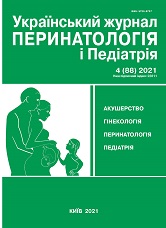Immunopathological value of interleukin-1β and interleukin-10 in lark fluid in children under 15 months
DOI:
https://doi.org/10.15574/PP.2021.88.32.Keywords:
interleukin-1β, interleukin-10, regulation of inflammationAbstract
Purpose — to determinate local immunity of the organ of vision in dacryocystitis in children under 15 months, study the effect of a microbiological preparation containing Escherichia Coli and Enterococcus faecalis (probiotics — Symbioflor) on it, as well as determinate the effectiveness of treatment with these drugs.
Materials and methods. Were studied immunograms in children under 15 months of age. Lacrimal fluid was collected using microcapillary pipettes to collect biological fluid. The study patients had not previously received any eye drops one week prior to tear collection and no therapeutic treatment. We examined 74 children, divided according to age, gender and diagnosis into two groups: group 1 (healthy). 18 somatically relatively healthy children without identified ophthalmological problems; group 2 (patients) — 56 somatically relatively healthy children with a confirmed diagnosis of neonatal dacryocystitis Each group is divided into three groups (up to 6 months, 7–12 months, 13–15 months). All patients underwent general clinical laboratory research.
Results and conclusions. In patients with neonatal dacryocystitis, the content of IL-1β in the lacrimal fluid is significantly higher than normal values, and IL-10 is below the age norm. The use of probiotics makes it possible to stabilize the content of IL-1β in the tears of patients with dacryocystitis of newborns. The use of this class of drugs does not affect the composition of the tears of healthy children, no changes are observed. The use of probiotics can be recommended in the complex treatment of neonatal dacryocystitis, since the drug is safe and helps to stabilize the local immunity of the conjunctival cavity.
The research was carried out in accordance with the principles of the Helsinki Declaration. The study protocol was approved by the Local ethics committee of the participating institution. The informed consent of the patient was obtained for conducting the studies.
No conflict of interest was declared by the authors.
References
Burmeister AR. (2018). The Interleukin 10 Family of cytokines and their Role in the CNS. Front Cell Neurosci. 12: 458. https://doi.org/10.3389/fncel.2018.00458; PMid:30542269 PMCid:PMC6277801
Subramanian S, Cheng G. (2012). Role of Interleukin 10 Transcriptional Regulation in Inflammation and autoimmune Disease. Clinical reviews in Immunology. 32 (1): 23-63. https://doi.org/10.1615/CritRevImmunol.v32.i1.30; PMid:22428854
Kurata M, Masumoto J et al. (2019). The Role of Interleukin 1 in general pathology NCBI. Additional article information. Inflamm Regen. 39: 12. https://doi.org/10.1186/s41232-019-0101-5; PMid:31182982 PMCid:PMC6551897
Roerink ME, van der Schaaf ME, Dinarello CA, Knoop H, van der MeerInterleukin JWM. (2017). Interleukin-1 as a mediator of fatigue in disease a narrative review. J Neuroinflammation. 14 (1): 16. https://doi.org/10.1186/s12974-017-0796-7; PMid:28109186 PMCid:PMC5251329
Serebrennikova SN, Seminskiy IZh, Semenov NV, Guzovskaya EV. (2012). Interleykin 1, Interleykin 10 v regulyatsii vospalitelnogo protsessa. Sibirskiy meditsinskiy zhurnal: 86.
Kasparova EA. (2002). O primenenii tsitokinov i ih kompleksov v oftalmologii. Vestnik oftalmologii. 4: 47–49.
Kovalchuk LV, Gankovskaya LV. (1995). Immunotsitokinyi i lokalnaya immunokorrektsiya. Immunologiya. 3: 4–6.
Kudryashova YuI. (2002). Rol sleznoy zhidkosti, ee kolichestvennogo i kachestvennogo sostava v razvitii sindroma «suhogo glaza». Vestnik oftalmologii. 6: 51–54.
Puchkovskaya NA, Shulgina NS, Mineev MG, Ignatov RK. (1983). Immunologiya glaznoy patologii. Moskva. Meditsina: 207.
Downloads
Published
Issue
Section
License
Copyright (c) 2022 Ukrainian journal of Perinatology and Pediatrics

This work is licensed under a Creative Commons Attribution-NonCommercial 4.0 International License.
The policy of the Journal “Ukrainian Journal of Perinatology and Pediatrics” is compatible with the vast majority of funders' of open access and self-archiving policies. The journal provides immediate open access route being convinced that everyone – not only scientists - can benefit from research results, and publishes articles exclusively under open access distribution, with a Creative Commons Attribution-Noncommercial 4.0 international license(СС BY-NC).
Authors transfer the copyright to the Journal “MODERN PEDIATRICS. UKRAINE” when the manuscript is accepted for publication. Authors declare that this manuscript has not been published nor is under simultaneous consideration for publication elsewhere. After publication, the articles become freely available on-line to the public.
Readers have the right to use, distribute, and reproduce articles in any medium, provided the articles and the journal are properly cited.
The use of published materials for commercial purposes is strongly prohibited.

